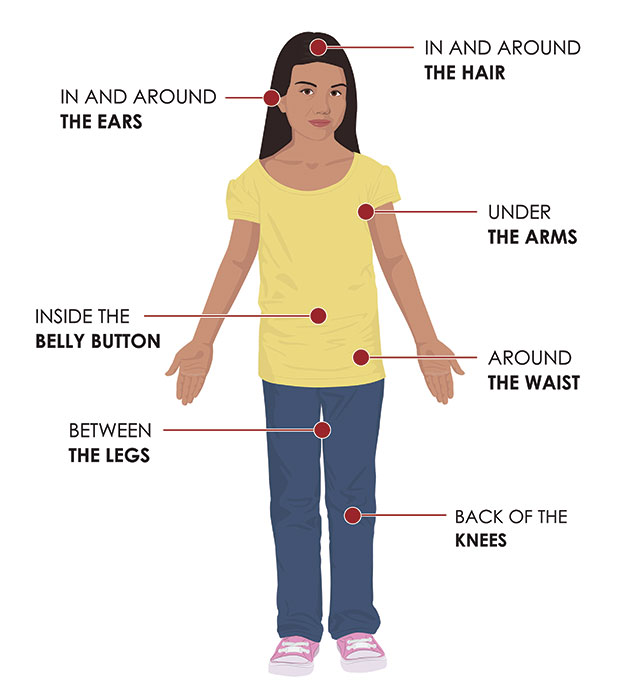Ticks are small parasitic arachnids, widely distributed around the world. They feed on the blood of a host animal, bird, reptile, or human. They wait to patiently in a position known as “questing”. Clinging to leaves and grasses, with two legs outstretched, they wait to grasp and climb on to any passing host. Some species are hunters and lurk near places where hosts may rest. Using a keen sense of smell, and a special sensory organ called Haller’s organ they can detect odors and chemicals emanating from a host, as well as sense changes in temperature and air currents.
Ticks are one of the more dangerous disease carrying vectors in the World. Ticks are implicated in the transmission of a number of infections caused by pathogens such as bacteria, viruses and protozoa. Sometimes the tick can harbor more than one type of pathogen, making diagnosis of the infection more difficult. Species of the bacterium Rickettsia are responsible for typhus, rickettsial pox, Boutonneuse fever, African tick bite fever, Rocky Mountain spotted fever, Flinders Island spotted fever and Queensland tick typhus (Australian tick typhus). Other tick-borne diseases include Lyme disease and Q fever, Colorado tick fever, Crimean Congo hemorrhagic fever, tularemia, tick-borne relapsing fever, babesiosis, ehrlichiosis, Bourbon virus and tick-borne meningoencephalitis, as well as bovine anaplasmosis and the Heartland virus.
Diligent self-care, prevention, and protection is needed to limit the chances of exposure to a potentially disease carrying and hungry tick.
Not all ticks in an infective area are infected with pathogens, and both attachment of the tick and a sustained feeding session are necessary for transmission of these diseases to take place. Tick bites do not necessarily lead to an infection, but any ticks should be removed promptly. Adult ticks can be removed with fine-tipped tweezers or proprietary tick removal tools, and the bite wound should be disinfected.
Most Common Tick Threats
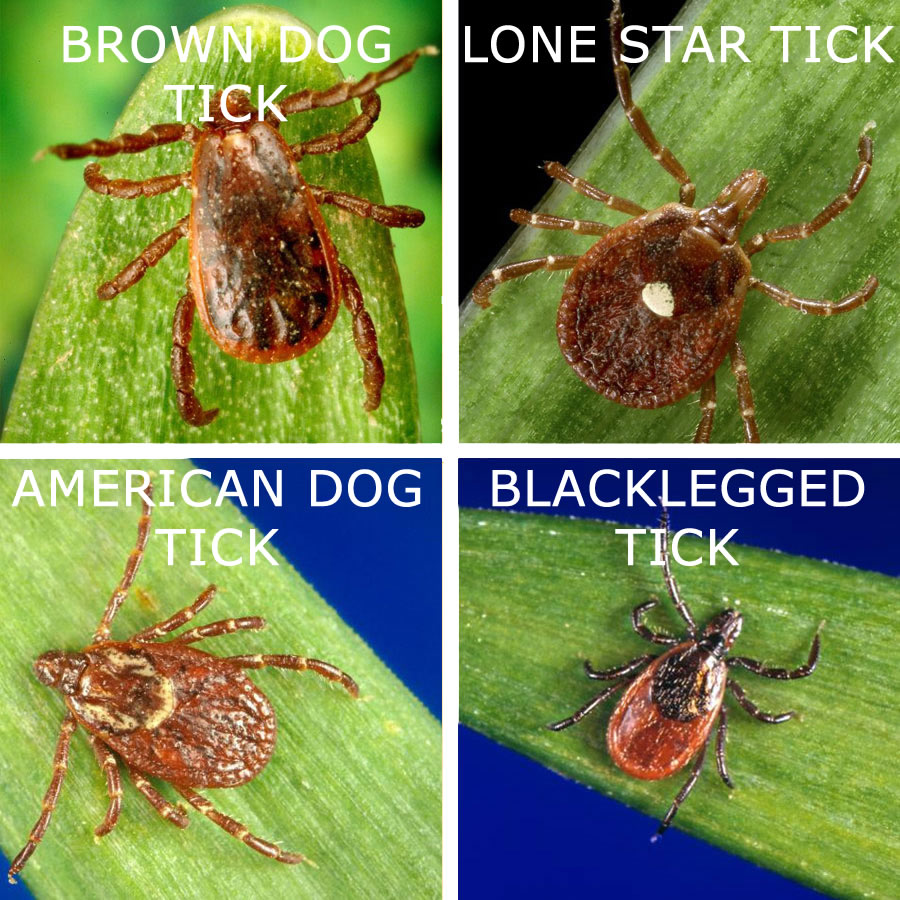
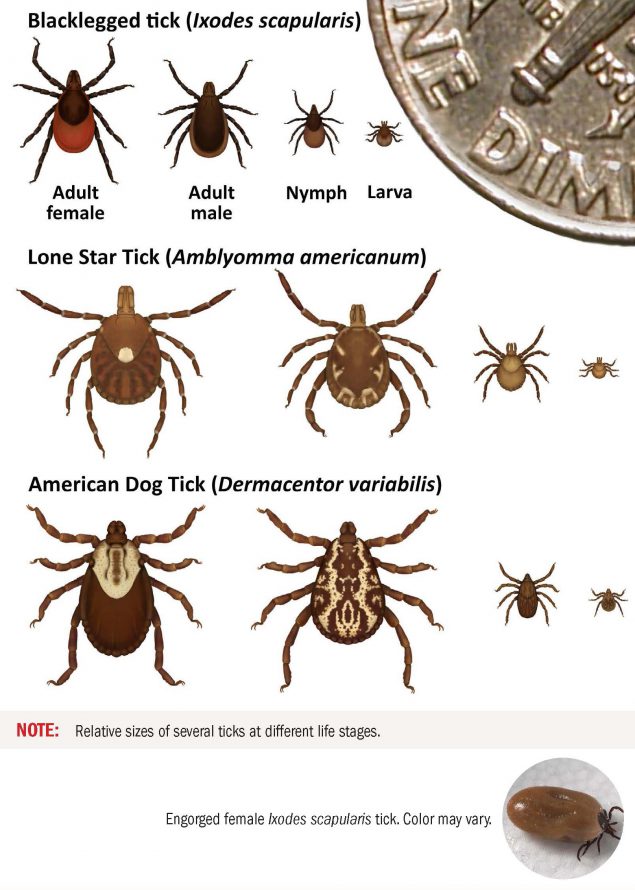
Types of Ticks, their Potential Diseases, and their Distribution.
BLACKLEGGED TICK ( Ixodes scapularis )

RANGE:
Widely distributed across the eastern United States.
DISEASE:
Lyme Disease ( Borrelia burgdorferi and B. mayonii )
Powassan Virus Disease ( )
Human Babesiosis ( Babesia microti )
Ehrlichiosis ( Ehrlichia muris eauclairensis )
Anaplasmosis ( Anaplasma phagocytophilum )
Relapsing Fever Disease ( B. miyamotoi )
COMMENTS:
The greatest risk of being bitten exists in the spring, summer, and fall in the Northeast, Upper Midwest and mid-Atlantic. However, adult ticks may be out searching for a host any time winter temperatures are above freezing. All life stages bite humans, but nymphs and adult females are most commonly found on people.
LONE STAR TICK ( Amblyomma americanum )
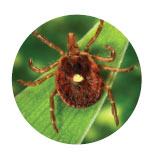
RANGE:
Widely distributed in the eastern United States, but more common in the South.
DISEASE:
Human Ehrlichiosis ( Ehrlichia chaffeensis and E. ewingii )
Tularemia ( Francisella tularensis )
Heartland Virus Disease ( Phleboviruses )
Bourbon Virus Disease ( thogotoviruses )
Southern Tick-Associated Rash Illness [STARI]
Red Meat Allergies
Cytauxzoonosis (risk to cats)
COMMENTS:
The greatest risk of being bitten exists in early spring through late fall. A very aggressive tick that bites humans. The adult female is distinguished by a white dot or “lone star” on her back. The nymph and adult females most frequently bite humans.
AMERICAN DOG TICK (Dermacentor variabilis )
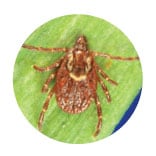
RANGE:
Widely distributed east of the Rocky Mountains. Also occurs in limited areas on the Pacific Coast.
DISEASE:
Tularemia ( Francisella tularensis )
Rocky Mountain Spotted Fever ( Rickettsia rickettsii )
COMMENTS:
The greatest risk of being bitten occurs during spring and summer. Adult females are most likely to bite humans.
BROWN DOG TICK ( Rhipicephalus sanguineus )
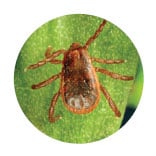
RANGE:
Worldwide.
DISEASE:
Rocky Mountain Spotted fever (Rickettsia rickettsii)
Other spotted fever group Rickettsias
Ehrlichia canis (risk to dogs)
Babesia vogeli (risk to dogs)
Hepatozoon canis (risk to dogs)
COMMENTS:
Dogs are the primary host for the brown dog tick in each of its life stages, but the tick may also bite humans or other mammals.
GROUNDHOG TICK ( Ixodes cookei )
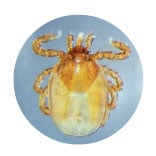
RANGE:
Throughout the eastern half of the United States.
DISEASE:
Powassan Virus Disease ( )
COMMENTS:
Also called woodchuck ticks. All life stages feed on a variety of warm-blooded animals, including groundhogs, skunks, squirrels, raccoons, foxes, weasels, and occasionally people and domestic animals.
GULF COAST TICK (Amblyomma maculatum )
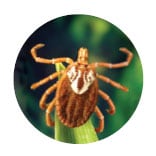
RANGE:
Southeastern and mid-Atlantic states and southern Arizona.
DISEASE:
Spotted Fevers (R. parkeri rickettsiosis)
Hepatozoonosis (dogs)
COMMENTS:
Larvae and nymphs feed on birds and small rodents, while adult ticks feed on deer and other wildlife. Adult ticks have been associated with transmission of R. parkeri to humans.
ROCKY MOUNTAIN WOOD TICK ( Dermacentor andersoni )
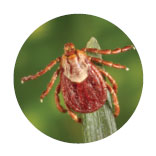
RANGE:
Rocky Mountain states.
DISEASE:
Rocky Mountain Spotted Fever ( Rickettsia rickettsii )
Colorado Tick Fever Virus (Colorado tick fever)
Tularemia ( Francisella tularensis )
COMMENTS:
Adult ticks feed primarily on large mammals. Larvae and nymphs feed on small rodents. Adult ticks are primarily associated with pathogen transmission to humans.
SOFT TICK ( Ornithodoros spp.)
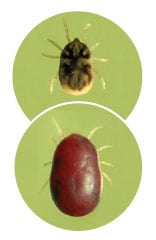
RANGE:
Throughout the western half of the United States, including Texas.
DISEASE:
Tick-Borne Relapsing Fever [TBRF] ( Borrelia hermsii and B. turicatae )
COMMENTS:
Humans typically come into contact with soft ticks in rustic cabins. The ticks emerge at night and feed briefly while people are sleeping. Most people are unaware that they have been bitten. In Texas, TBRF may be associated with cave exposure.
WESTERN BLACKLEGGED TICK (Ixodes pacificus )
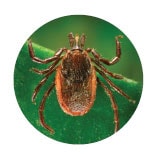
RANGE:
In the Pacific Coast states.
DISEASE:
Lyme Disease ( Borrelia burgdorferi and B. mayonii )
Anaplasmosis ( Anaplasma phagocytophilum )
Relapsing Fever Disease ( B. miyamotoi )
ASIAN LONGHORNED TICK (Ixodes pacificus )
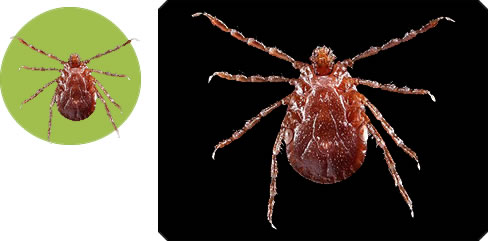
https://www.health.com/condition/lyme-disease/asian-longhorned-tick
RANGE:
In the East Coast states and spreading.
DISEASE:
Human Ehrlichiosis ( Ehrlichia chaffeensis and E. ewingii )
Anaplasmosis ( Anaplasma phagocytophilum )
Human Babesiosis ( Babesia microti )
Spotted Fevers (R. parkeri rickettsiosis)
Severe Fever with Thrombocytopenia Syndrome
Theileriosis ( risk to cattle)
COMMENTS:
Recently discovered in nine East Coast States, and spreading. Initial attempts to eradicate the species from New Jersey failed; the tick successfully overwintered and has since become established.
In contrast to most tick species, a single female tick can reproduce offspring (1-2,000 eggs at a time) without mating. As a result, hundreds to thousands of ticks can be found on a single animal, person, or in the environment.
It has been deemed a serious risk to people, pets, and livestock. In other parts of the World where it is found, it is know to carry a host of diseases including the bacteria responsible for Lyme Disease.
Tick-borne Disease Distribution
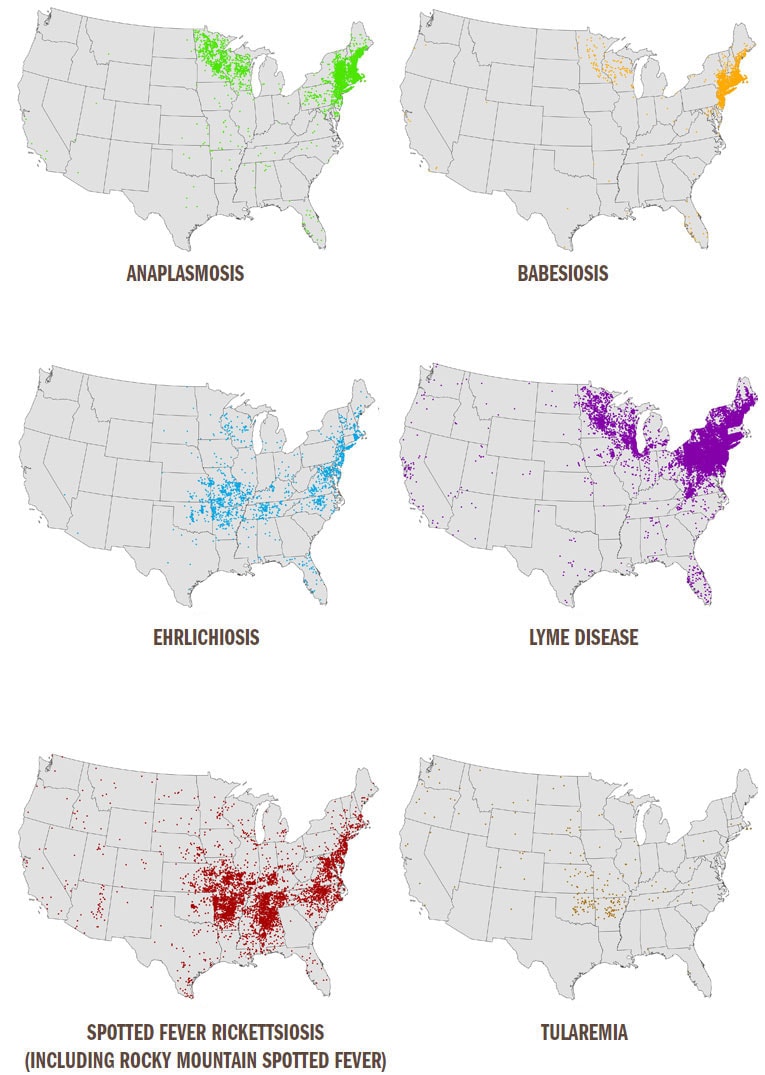
Each dot represents one case. Cases are reported from the infected person’s county of residence, not necessarily the place where they were infected.
NOTE: In 2016, no cases of tick-borne illness were reported from Hawaii.
Alaska reported 6 travel-related cases of Lyme disease and 1 case of tularemia.
Lyme disease was reported in every mainland state.
Babesiosis was reported in Alabama, Arkansas, California, Connecticut, Delaware, Illinois, Indiana, Iowa, Louisiana, Kentucky, Maine, Maryland, Massachusetts, Michigan, Minnesota, Missouri, Montana, Nebraska, New Hampshire, New Jersey, New York, North Dakota, Ohio, Oregon, Rhode Island, South Carolina, South Dakota, Tennessee, Texas, Utah, Vermont, Washington, West Virginia, Wisconsin, and Wyoming.
Anaplasmosis and ehrlichiosis were not reported in Colorado, Idaho, New Mexico, Alaska, Hawaii in 2016.
Spotted fever rickettsiosis was not reported in Alaska and Hawaii in 2016.
Preventing Tick Bites

Tick exposure can occur year-round, but ticks are most active during warmer months (April-September). Know which ticks are most common in your area.
- Know where to expect ticks. Ticks live in grassy, brushy, or wooded areas, or even on animals. Spending time outside walking your dog, camping, gardening, or hunting could bring you in close contact with ticks. Many people get ticks in their own yard or neighborhood.
IF you are venturing into deep wooded and thick grass land where high numbers of ticks are known to reside.. Your safest known prevention is to be fully prepared with extra tick repellent spray and to wear clothes that have been treated with Permethrin.
General Precautions
Treat clothing and gear with products containing 0.5% permethrin. Permethrin can be used to treat boots, clothing and camping gear and remain protective through several washings. Alternatively, you can buy permethrin-treated clothing and gear.
Commercial Insecticides and Repellents containing DEET, picaridin, IR3535, Oil of Lemon Eucalyptus (OLE), para-menthane-diol (PMD), or 2-undecanone, are fairly effective, but should be used with all precautions listed on the manufacturers packaging. More natural and safer repellent sprays can be used for children and infants.
Always follow product instructions.
Do not use insect repellent on babies younger than 2 months old.
Do not use products containing OLE or PMD on children under 3 years old.
Best to Avoid Contact with Ticks
- Avoid wooded and brushy areas with high grass and leaf litter.
- Walk in the center of trails.
Checking for Ticks
Check your clothing for ticks. Ticks may be carried into the house on clothing. Any ticks that are found should be removed. Tumble dry clothes in a dryer on high heat for 10 minutes to kill ticks on dry clothing after you come indoors. If the clothes are damp, additional time may be needed. If the clothes require washing first, hot water is recommended. Cold and medium temperature water will not kill ticks.
Examine gear and pets. Ticks can ride into the home on clothing and pets, then attach to a person later, so carefully examine pets, coats, and daypacks.
-Shower soon after being outdoors. Showering within two hours of coming indoors has been shown to reduce your risk of getting Lyme disease and may be effective in reducing the risk of other tick-borne diseases. Showering may help wash off unattached ticks and it is a good opportunity to do a tick check.
Check your body for ticks after being outdoors. Conduct a full body check upon return from potentially tick-infested areas, including your own backyard. Use a hand-held or full-length mirror to view all parts of your body. Check these parts of your body and your child’s body for ticks:
- Under the arms
- In and around the ears
- Inside belly button
- Back of the knees
- In and around the hair
- Between the legs
- Around the waist
